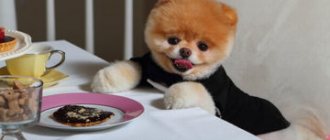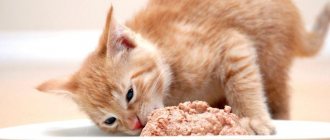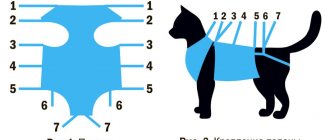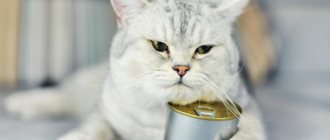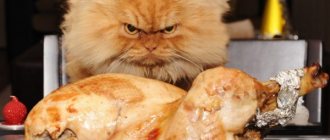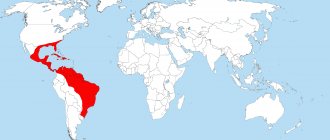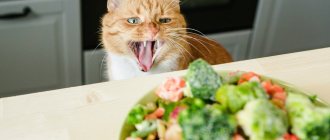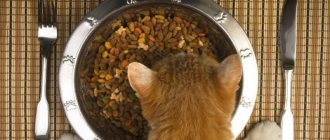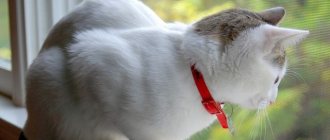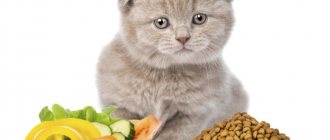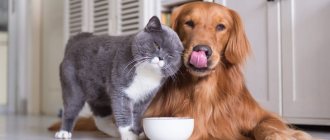What will you learn from the article?
- Feeding cats with prepared food
- Feeding cats natural food How many times to feed?
- How to feed a cat correctly
When your cat reaches the age of 1 year, it is time to completely switch to the diet and feeding regime of an adult animal. The thing is that the diet of a kitten and an adult cat is significantly different. In order to maintain health and a playful mood, read on about what to feed your cat. Main differences from kitten nutrition:
- firstly, adult cats need to be fed less often and in larger portions,
- secondly, the balance of nutrients, vitamins and minerals in food for babies and mature individuals also varies.
If she needs to gain weight
Excessive thinness has a negative impact on a cat's health. If there is a lack of weight, and the veterinarian has not identified any pathologies, then you need to reconsider your pet’s diet. Non-pathological causes of excessive thinness in cats include:
- lack of nutrition for any reason;
- feeding a large number of kittens;
- consequences of improper feeding;
- recovery period after illness.
Non-castrated cats walking freely in nature can lose significant weight after a long period of cat weddings, when, under the influence of hormones, the pet is able to not return home or eat for a long time.
The diet for a castrated cat with reduced weight should be selected based on the following three rules:
- taste preferences - if you like the food, then there will be no difficulties with feeding;
- high calorie content of food - it is important to increase the protein content in the cat’s diet, which will allow it to build muscle mass rather than fat;
- Determine the daily calorie content of a serving with a veterinarian.
Meat is the main ingredient
Until the cat regains normal weight, you should give food in small portions, dividing the daily amount of food into 5-6 times. This way, absorption will go better, and the risk of fat deposits appearing instead of restoring muscle mass will be minimized.
If a cat eats ready-made industrial food, then in order to gain weight it should be given the diet that the manufacturer offers for this purpose. In this case, all recommendations for feeding this particular product line will be additionally indicated on the product packaging.
For pets who are on a natural diet, the following products will be useful:
- lean beef and chicken - this meat should be the basis of the diet, as it contains a lot of protein necessary for gaining muscle mass;
- bran and oatmeal are sources of coarse fiber, which improves the functioning of the gastrointestinal tract;
- buckwheat and rice - add vitamins and minerals to the diet;
- boiled vegetables - zucchini, pumpkin, carrots and green beans. They are boiled and, after grinding into puree, added to meat to fortify the diet;
- hard-boiled chicken or quail egg - given 2 times a week;
- heart, liver, kidneys - you can give chicken, beef and turkey, scalded with boiling water or boiled;
- sea fish – lean, boiled, pitted;
- baby food;
- low-fat cheese.
If the cat is in poor condition and cannot eat normally on its own, it can be given mash made from baby food and baby milk. How to feed your pet in such a situation should be discussed with your veterinarian.
If, with proper nutrition, the cat remains excessively thin and has no pathologies, then most likely she suffers from worms, due to which she does not receive enough nutrients.
Recipes for cats
Below are options for cat dishes that take into account the rules of diet composition. Such recipes are quick and easy to prepare, and the owner does not have to stand at the stove for hours.
Beef meatballs
Take 2 kg of beef, 200 g of rice, a pack of frozen vegetables, 100 ml of beef broth.
Boil beef, rice and vegetables. Cool the ingredients and mix with the broth in a blender. Divide into portions and put the meatballs in the freezer: this amount will be enough for the cat for a week.
Buckwheat chicken
You will need 200 g of chicken meat, half a glass of buckwheat, 3-4 heads of broccoli and 1 tbsp. l. vegetable oil.
Rinse the buckwheat, pour boiling water over it and leave to steep overnight. Boil the chicken and broccoli, cut into small pieces. Mix all ingredients and season with oil.
Salmon with rice
150 g salmon, half a boiled egg, half a glass of rice.
Steam the salmon, remove the bones, and boil the rice. Mix all ingredients.
To lose weight
Obesity is a fairly common pathology in pets that requires mandatory treatment. Excess weight has an extremely negative impact on the condition of internal organs and provokes the development of a number of severe pathologies that pose a direct threat to life.
Obesity is common among modern cats
When using a ready-made diet, as in the case of underweight, it is enough to simply choose a line of food intended for cats suffering from obesity.
The main manufacturers of premium and super-premium food have diets for overweight cats.
When an obese pet is on natural feeding, the situation with the selection of food for getting rid of excess weight is somewhat different. First, it is better to consult a veterinarian and evaluate the diet together with a specialist. It is often necessary to take tests from the cat to determine whether there are hormonal imbalances or whether the disease is caused by an excess of calories entering the body due to poor diet or too large portions.
General recommendations for natural feeding of overweight cats include reducing portion sizes and increasing the amount of cereal in the diet. It is useful to give low-fat, but not low-fat kefir and cottage cheese.
If a cat eats a balanced diet and does not receive treats from the owner’s table, but gains weight, then this is a symptom of pathology and requires contacting a veterinarian.
How to support the old one
The average lifespan of cats is 12 years. At the age of 8 years, the pet is already called senior. The cat's body begins to age early, and irreversible changes occur in it, leading to the need to reconsider its diet. Food manufacturers have special product lines for older and elderly cats. They include everything necessary to maintain health and prevent the appearance of many age-related disorders.
Natural feeding should be adjusted for cats entering old age. The basis of their diet is beef, and chicken is given occasionally. The meat is first boiled or scalded. To speed up digestion and prevent constipation, you need to add a little bran to meat or porridge once a day. To avoid age-related problems with bones, it is necessary to increase the calcium content in the diet, for which low-fat cottage cheese is given 3 times a week. Vegetables continue to be included in meals as before. Boiled offal is given in ground form.
Fish is contraindicated for older cats, as it leads to the development of urolithiasis in them.
For older pets, certain feeding requirements must be observed. With age, the digestive system of cats begins to work weaker, and it is necessary to treat it more delicately. Because of this, the daily amount of feed should be divided into at least 4 feedings. It is important to work with your veterinarian to select vitamin and mineral supplements that will support the body. Due to dental problems, an older cat may begin to refuse solid food. In this case, you will need to replace it with a soft one or grind it.
Cat without teeth
Feed classes
Industrial cat food is divided into three classes:
- Economy
- Premium and superpremium
- Holistic
The classification is based on the quantity and quality of products. The price also depends on the class.
Economy class
At first glance, this is the most budget option. But these foods can cause health problems for animals due to their low protein content, high amounts of soy, artificial colors and oxidizing agents. Sometimes they may even consist of bran alone. Cheap food is similar to fast food for people and is useful in much the same way as instant soups.
Daria Tarasova veterinarian
5,0 99
Open profile
As a dermatologist, I very often encounter unwanted food reactions - itching, irritation and hair loss - to economy class spiders. These foods contain insufficient quantity and quality of protein to keep your cat healthy, as well as questionable quality ingredients. In addition, many flavoring additives are added to make the food more appetizing to the animal.
It turns out that the low price of economy food is deceptive - after all, such food will most likely require the owner to spend money on a veterinarian and medications. In addition, supposedly budget wet food is actually more expensive than premium dry food.
Pavel Klimov veterinarian
5,0 131
Open profile
Let's look at the example of a hypothetical three-kilogram sterilized cat and premium food. The cost of a package weighing 2 kg is approximately 1000 rubles, the daily requirement of a cat is about 50 g. It turns out that such a package will last for 40 days, 25 rubles per day. A bag of economy class food costs an average of 20 rubles. And this is only for one feeding, and there are two or three of them a day - a total of 40-60 rubles. It turns out that the dry premium diet is almost 2 times cheaper than the wet economy diet.
Premium class
According to experts, this is the best ready-made food option that suits most animals. Nutritionists work on the composition, monitoring not only the quality of the products, but also the method of their preparation. For example, cheap canned food has few nutrients - they are partially destroyed during heat treatment. In expensive feeds, the possibility of such losses is taken into account in advance.
Holistic and medicinal foods
Separately, there are “holistic” or Human Grade foods. All of their ingredients are suitable for human use. It contains a lot of protein - fresh meat, easily digestible carbohydrates - potatoes, peas, lentils, fiber - vegetables, fruits, berries. And also natural preservatives and high-quality vitamin and mineral supplements.
Veterinarian Tatyana Khleborad notes that such food is suitable for animals that have an additional burden - for example, they are free-range, pregnant or sterilized.
But if your pet has kidney or liver problems, this diet may worsen the disease. In this case, you need to select products from the medicinal line, which is available from all major manufacturers. They are formulated taking into account the special needs of the animal, but at the same time they do not differ much in taste from regular food - so it is easy to accustom the cat to them.
Than toothless
Not only people have problems with teeth, but also cats. Age-related changes in the body can even lead to their complete loss. In this case, difficulties arise with feeding the pet, which can no longer fully consume much of its usual food.
First of all, solid foods should be excluded from the diet of a cat that has lost teeth.
The hard ones will need to be crushed. Dry food will have to be completely removed from the diet, since if a pet has no teeth, swallowing pieces of it can easily choke, which is life-threatening. Solid foods are replaced with special pates for older cats, which help to avoid digestive problems that develop when switching to only a soft diet.
With natural feeding, there is no need to give up foods provided to older cats. In order for your pet to eat properly, you will need to grind the food. For very old cats without teeth who have a severe decrease in appetite, you should put all food through a blender.
Which food is better - dry or natural?
Both types of nutrition have pros and cons. If we talk about an industrial diet for cats, then your pet should be fed premium or super-premium food. Economy class food, such as Whiskas or Kitty Ket, will do nothing but harm to the cat, although at first glance it seems profitable and cheap. The advantage of a ready-made diet is its balance and convenience in the country. Its disadvantage is the high price compared to natural food, and also the fact that it is almost impossible to purchase food of such a high category in a regular supermarket.
Natural feeding for a cat is cheaper and tastier, but for the owner it will be an unnecessary concern. You will need to constantly monitor a balanced diet, regularly prepare fresh food and give it only at room temperature. The main disadvantages of this feeding are:
- the need to strictly observe the proportions of components in the diet;
- the need to regularly enrich the diet with vitamin and mineral complexes;
- difficulties when giving vegetables - many cats refuse them, even when vegetables are added to meat;
- the need to pit fish and boil it if it is river fish;
- searching for dairy products with the required fat content of at least 10-15%.
Any mistakes when choosing products to feed your cat will negatively affect its health.
Which feeding to choose depends on the personal wishes of the cat's owner. The exception is cases when the pet needs to be given therapeutic food, and then only a ready-made industrial diet can be used.
Food from our table is undesirable
Features of cooking for cats
You can’t give your cat what you cooked for dinner: the human diet is different from the cat’s. It is better to prepare food for your pet separately.
When cooking meat, poultry and fish, it is better to boil or steam it - this way the meat will definitely be treated from parasites. Frying and baking in oil are undesirable: excess fat is harmful to the cat's body.
Do not add spices and sugar to your pet's food - this can lead to illness. You should be careful with salt. Use only iodized salt, no more than half a teaspoon per kilogram of meat.
You can also add vitamins E, B and taurine to the food - it is better to discuss the amount of additional ingredients with your veterinarian.
It is advisable to chop the cooked food into small pieces; ideally, you should put the cat's dinner through a blender. To avoid cooking for your cat every day, the food can be divided into portions and frozen. Before serving, you should warm the food to room temperature.
Why not from the table?
Not all foods can be given to cats. Some of them are strictly prohibited for pets, although they really love some. The owner should not assume that the cat himself knows what he can and cannot do.
The natural ability to determine what is edible and not edible for oneself has long been absent from any domestic animals. There is no need to risk their well-being. The following treats are harmful to your pet’s health, even as a treat:
- chocolate and any products containing cocoa - cocoa contains theobromine, a substance that is deadly for cats, which is not decomposed by the body and is not eliminated from it, being deposited and accumulating in the liver;
- alcohol and drinks containing hops are also unable to be excreted from the body and are dangerous to the health of the pet;
- tea and coffee - high doses of caffeine that are present in these drinks lead to severe disturbances in the functioning of the heart and blood vessels;
- mushrooms – cause severe intoxication and can cause instant death;
- potatoes and tomatoes - the alkaloid in their composition provokes severe intestinal damage in cats if the vegetables are given in large quantities;
- avocado - the fruit contains persin, which is dangerous for your pet and can lead to death;
- onions and garlic - provoke anemia, since disulfite from their composition causes premature death of red blood cells;
- sorrel and rhubarb - oxalic acid is poisonous to cats and can cause kidney failure;
- stone fruits - they contain hydrocyanic acid, which causes an attack of suffocation;
- grapes (raisins), persimmons and citrus fruits - they cause diarrhea and vomiting (moderate to severe);
- fish, poultry and meat bones can damage the intestines up to the point of rupture, when even with urgent veterinary care it is not always possible to save the injured pet.
It is also undesirable to give legumes to cats, as they lead to bloating.
You should not feed your pet from your table, as salt, spices and excess fats negatively affect the cat’s health. Also, not all substances from certain products are acceptable for use by a cat. Because of this, food for her must be prepared separately. Treats from the master's table only bring harm to the pet.
Norms
Dry food should be given according to certain standards.
| Weight of an adult cat in kilograms | Norm of dry food per day in grams | Kitten age in months | Norm of dry food per day in grams |
| 3 | 45 | 1-2 | 30-50 |
| 4 | 55 | 2-4 | 40-65 |
| 5 | 65 | 4-6 | 55-70 |
| From 6 kg | 12 g per 1 kg of weight | 6-12 | 60-80 |
Wet food contains water, and therefore their daily consumption rate will be different.
| Weight of an adult cat in kilograms | Norm of wet food per day in grams | Kitten age in months | Norm of wet food per day in grams |
| 3 | 190-200 | 2-3 | 170-210 |
| 4 | 230-240 | 3-6 | 210-300 |
| 5 | 250-260 | 6-9 | 210-300 |
| From 6 kg | 300 | 9-12 | 170-255 |
With natural feeding, norms are calculated for all types of products the cat needs, depending on its weight.
| Cat's weight in kilograms | Meat and offal per day in grams | Cereals in grams 3 times a week | Vegetables in grams daily | Fermented milk products daily in grams |
| 3 | 80 | 45 | 10-15 | 70 |
| 4 | 100 | 60 | 20-30 | 80 |
| 5 | 125 | 75 | 25-35 | 100 |
| 6 | 150 | 90 | 30-40 | 130 |
All feeding rates are average and usually require some minor individual adjustments for a particular cat, depending on the characteristics of its living conditions and general condition.
Spiders with wet food
Types of cat food
Industrial feeds are divided into three types:
- dry,
- semi-dry,
- wet.
| Dry (6-10% moisture) | Semi-dry (35% moisture) | Wet (75% moisture) | |
| Compound | Meat, fish, poultry or organ meats, grains, vitamins and mineral supplements | Meat, fish, poultry or by-products, grains, vitamins and mineral supplements, preservatives | Meat, fish, poultry or by-products, grains, vitamins and mineral supplements, preservatives |
| pros | The best ratio of price and feed consumption. Prevents the formation of dental plaque. It can be stored for a long time. | Smells and tastes attractive to cats. Suitable for cats that cannot eat dry food. | Provides the cat's need for water. Suitable for sick and elderly animals. The most delicious food, liked by most cats. |
| Minuses | Weak smell and taste. You need to make sure your cat always has water. | Costs more than dry. Contains more sugar than other types of food. If opened, it dries out or deteriorates quickly. | High price. It deteriorates quickly when opened. |
Dry and semi-dry food
It’s most convenient for owners who feed their pets on a flexible schedule: if you pour dry food into a bowl in the morning, it will remain fresh and tasty until the evening. This is also a suitable option for cases when you need to go away for 1-2 days and leave the cat alone. The main disadvantage of dry food is that it contains virtually no moisture, so the animal should always have fresh water in a bowl, water bottle or drinking fountain.
In July, Roskachestvo published a rating of 39 feeds from well-known manufacturers. The top 5 brands included:
- Orijen
- Nutram
- Pronature
- Now Fresh
- Acana
Dry and semi-dry food should be stored in a hermetically sealed bag, monitor the expiration date and not buy in bulk - it is unknown how long they have been left open.
Wet food
Suitable for sick and convalescent cats, as well as old animals that find it difficult to chew dry pellets. This food contains enough liquid, so cats drink very little.
The main disadvantage is that spiders and canned food spoil quickly. If the cat does not eat the portion immediately, after half an hour the product will dry out and dry out in the evening. Therefore, the leftover food is thrown away, and the printed packaging is stored in the refrigerator, tightly closed, for no more than 2-3 days.
Another disadvantage of wet food is that it does not prevent the formation of plaque. Therefore, if your cat eats canned food, then she needs to brush her teeth periodically.
Careful, treats!
When choosing wet food, be sure to check that it is suitable for daily feeding. Sometimes owners confuse it with a treat. For example, it could be pouches or gourmet canned food. And although they look the same, this is just a “dessert” and not a full meal.
Treats are needed to restore interest in food in a sick or picky cat, or to pamper an animal if it is stressed from moving, having a new pet, or changing owners.
Is it possible to mix?
Experts believe that it is acceptable to give your cat both dry food and canned food at once. But it is important to consider two points:
- do not mix different types of food in one bowl;
- choose food from one manufacturer.
Products from different companies are mixed just to switch a cat from one type to another.
Daria Tarasova veterinarian
5,0 99
Open profile
Dry and wet industrial food can be given together if it is the same brand and line - they differ only in the amount of water in the composition. It is important that both foods contain the same type of protein - for example, you should not give dry food with fish, or wet food with turkey.
Is it worth having diversity?
By nature, cats love consistency. This also applies to food. Therefore, not all pets react positively to changes in diet and the introduction of new foods. When food with different tastes from the same manufacturer and from the same category is used, problems should not arise. If the manufacturer changes, then the cat may go on a hunger strike. This is due to the fact that the smell and taste of the new product will be significantly different from the usual ones.
It is highly undesirable to use feed from different categories, especially if their quality decreases. In this case, there is a high risk of intestinal problems.
It is permissible to mix soft food and dry food only if the cat receives such food constantly. When mixing occurs once, the intestines may not be able to cope with a sharp change in the consistency of food and react with both diarrhea and severe inflammation.
You cannot mix natural and ready-made, industrial feeds. A cat's stomach cannot accept both types of food at the same time, since the speed of their digestion and absorption varies significantly.
General information about natural feeding for cats
Cats are carnivores, so feeding them natural food is more natural for them. Many owners switch their pets to industrial food and there are a number of reasonable reasons for this.
It is worth understanding that industrial food is a worthy alternative to natural food if:
- You don't have time to cook for your cat, so dry food is better than table scraps.
- A cat needs therapeutic nutrition, for example, in case of acute allergies or urolithiasis.
- You do not have the opportunity to purchase high-quality (natural) products.
- Neither you nor the veterinarian can choose the optimal diet for a cat, that is, the animal constantly suffers from vitamin deficiency or metabolic disorders.
Note! After surgery, it is reasonable to switch a sterilized cat to a low-salt diet, but not to food that affects metabolism.
Cats need a balanced diet, but there are a few important points. For normal life, a person needs to consume proteins, fats, carbohydrates, vitamins, microelements and amino acids. The cat has everything the same except for carbohydrates. Your pet’s body synthesizes slow carbohydrates, from which the granite receives enough energy to nourish the brain. Simply put, a cat does not need additional carbohydrates unless there is a specific reason for them to be consumed . Porridge is usually used as an addition, but it should be the basis. Ideally, a healthy cat's diet should not contain more than 10% carbohydrates.
If left without food as punishment
You cannot punish a cat by refusing to feed it. This will not only not bring the expected result, but will also have an extremely negative impact on health. First of all, such punishment will lead to the fact that the pet will experience severe stress, since he will not be able to connect his wrong action with the lack of food, but will perceive it only as the onset of a period of hunger. As a result, a depressive state develops, which can lead to disturbances in the cat’s behavior.
Lack of food will also negatively impact your physical health. Cats are not designed to go long without food, and due to hunger their liver and stomach are quickly damaged. As a result of punishment by hunger, the owner will not only not achieve what he wants, but will also be faced with the need to treat the pet.
Plastic bowl
Disadvantages of food from a bag
Everyone knows that the main advantage of such a product is economy. In addition to the low price, the owner does not waste time on preparation. The benefits of such a product are also widely advertised. But in addition to all the necessary elements, the body also receives harmful substances with food.
After all, in order to understand all the diversity of such a drug, you need to be an ace in this matter. Attention should also be paid to the expiration date, manufacturer's brand and chemical composition. Another disadvantage is that processed food is addictive, and often pets categorically refuse other food.
But there is also a positive side to such products. Owners cannot balance the menu on their own, but well-known and responsible manufacturers offer special products for certain groups of animals. For example, there are no problems with choosing products from branded companies when feeding castrated and sterilized cats is on the agenda.
Which bowl do we recommend?
Feeding utensils are of great importance. It must be of high quality and intended specifically for food. If you wish, you can use dishes for people, but it is still better to buy your pet your own utensils, which are designed for the cat and will be more convenient for her.
Varieties
Cat bowls, like dog bowls, can be made from metal, plastic and ceramic. All these dishes have their pros and cons. When choosing bowls for your pet, it is worth finding out the differences between those made from different materials.
- Metal bowls. Such dishes are hygienic, since the material is not porous. It is also durable and has enough weight to prevent your cat from tipping it over. This dish does not accumulate static electricity, which causes discomfort in cats. It is only important that the bowl is made of stainless steel, otherwise it will oxidize from contact with food, and this is unacceptable. The disadvantage of such bowls is that if the cat moves them while eating, this is accompanied by noise. Also, this cookware is quite expensive.
- Plastic bowls. The cheapest option, but undesirable for cats, as it is porous and does not provide sufficient hygiene. It is also not uncommon for cats to be allergic to plastic. The advantages of such bowls are their low price.
- Ceramic bowls. Ceramics are the most versatile and hygienic. Also, these bowls do not make noise like metal ones. When choosing such dishes, you need to make sure that the glaze does not contain lead. The disadvantage of ceramics is that they break easily.
You should not use a double bowl for food and water. The water must be constantly clean, but with such dishes this is impossible - pieces of food will fall into the drinking bowl. Because of this, you need to buy separate bowls for water and food, which will stand at a distance from each other. Better yet, purchase a special automatic waterer for cats that has a built-in filter. It is he who will retain any dirt and unwanted impurities.
Special bowl for slow feeding
For slow feeding
Slow feeding bowls are special utensils. They are needed if the pet has an eating disorder, in which food is swallowed too quickly, which causes vomiting.
They are also used as a toy. These bowls are made of plastic and have grooves at the bottom from which the cat has to choose food. This feeder is best suited for dry food.
It should not be used for natural feeding, since due to the texture of the bottom it will be more difficult to wash than a regular one.
The advantage of these bowls is that they not only slow down the absorption of food, since getting it out of the slots takes time, but they also turn eating into a game. For lazy pets prone to obesity, this is also a way to reduce portions and at the same time ensure that the cat does not suffer. Feeding will stretch out over time and the food will begin to be absorbed, eliminating the feeling of hunger by the time the dishes are empty.
Other accessories
Mats for cat bowls are often purchased. They are only necessary if the dishes move across the floor due to their low weight, or if the cat itself displaces the bowl when eating due to individual habits. The rug is also convenient because when a cat is nocturnal, there will be no noise when eating or drinking water, even if it moves the dishes. Additionally, the mat helps keep the floor clean in the feeding area. Not many pets eat carefully, without taking some of the food out of the bowl. The high water resistance of this mat protects the floors from getting wet if the cat has a tendency to splash the contents of the drinking bowl.
Such mats are made from non-slip material of increased strength, most often latex or rubber are used. Mats come in a variety of sizes and can be made to fit one or more bowls.
Toyger cats, description, history of the breed, photos and price in rubles for kittens
The manufacturer of the rug must be reliable, otherwise there is a risk that a product will be purchased that does not meet sanitary requirements. The item should not have an unpleasant odor.
Automatic cat feeders are convenient if the owner cannot give the pet food on time because he spends a long time outside the home. This feeder dispenses food in portions at a certain time. Using such a device for feeding a cat will also allow you not to worry that your pet will wake you up on a weekend morning, since it is used to receiving food early on weekdays. The disadvantage of such a device is its high cost. The most inexpensive model will cost about 2 thousand.
Water quality is equally important
And finally, a few words about water. The structure of the feline excretory system is such that urine accumulates quite slowly and is very concentrated. But this does not mean that a cat can go without fluid for a long time.
The animal must have constant access to clean, fresh water. At the same time, the quality of water should be given no less attention than the quality of food. If water from the tap (or well) can be safely used for cooking (that is, it is transparent, does not have a pronounced taste or smell, including bleach), it is also suitable for pets.
In other cases, it is advisable to use bottled water (from trusted manufacturers) or filtered using household purification devices.
Veterinarian advice
- Cat food must be of high quality. Natural food is prepared for a maximum of 2 days. After opening, canned food is stored in glass in the refrigerator for 24 hours. Dry food is kept hermetically sealed. It is convenient to pour them from a bag into a jar.
- You can evaluate how suitable a cat’s diet is by looking at how its intestines work. Diarrhea and constipation indicate the need to reconsider your pet's diet.
- The amount of water a cat drinks increases when feeding dry food. The water in the drinking bowl should be changed 2 times a day.
- Chronic pathologies and food allergies require the selection of a diet together with a veterinarian.
- The cat's nutrition should vary depending on the age and characteristics of its current condition.
- Economy class food is dangerous for pets' health. They are not balanced in composition and have low quality components. They also contain a high percentage of plant products, which disrupts the cat’s condition.
